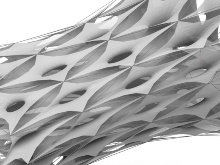Functional Form without Geometry
Generating Integrated Systems through Computing Material Behaviour
UTS Masterclass Sept 2010
Sean Ahlquist will be running a 10-day intensive Masterclass for the School of Architecture at the University of Technology in Sydney. The following is the description for the research to be accomplished during the Masterclass:
The challenge in designing tension-active systems (where the application of tension force defines a material's shape) is that their forms do not follow simple mathematical geometric descriptions. This does offer an advantage, though. By avoiding the discreet definition of geometry, and concentrating on the simulation of how force influences form (defining material behaviour), we can more thoroughly investigate the different formal and functional possibilities of tension-active structures - we are not locked into a particular geometric strategy. This is what we can call "form without geometry." Utilizing a program that has been developed with Particle Systems and Springs in Processing, we will investigate, in this workshop, the variation and manipulation of the fundamental relationships between form and force.
This workshop will involve a series of experiments in developing computational and physical models for multi-capacitive tension-active architectural systems. The functionality will emerge from a system comprised of tensioned textile (termed 'membranes') and tensioned mesh (termed 'cable-net') elements. As a tension-active system, the form and arrangement of these materials elements is dictated primarily by the application of tension force. We will also concentrate, beyond the formal qualities of these translucent lightweight structures, on the ability to apply photo luminescent materials to the membranes so that they may act as energy gathering and light emitting surfaces.
Students will work in groups of two or three across a spectrum of topics and application for the first half of the workshop. All will focus on a computational description and physical prototypes based on a certain material behaviour. Some will concentrate on cable-net meshes by studying various topologies; others will concentrate on defining variable types of membrane "cells", while others will work to calibrate the performance of the membrane material as a light emitting source. The focus will be to add new component types to the Processing library based on the material experiments. In the last half of the workshop, we will combine the knowledge, techniques and technologies from each group for the production of a large scale interior prototype.


